| Return to
BibleProbe.com
|
Webster defines dilemma as a problem "seemingly incapable of a satisfactory solution." The problem for evolutionists is to develop a theory of origins that would account for the intricate design mechanism of biological pollination. Evolutionists believe that in order to attract pollinators, some plants have adapted to bribe insects, birds and other animals with a meal of nectar or pollen. The basic tenet of evolutionary theory is there is no intelligence involved in the process. One cannot have it both ways. Either an intelligent personal Designer planned and executed the process of biological pollination or it just happened to occur in some mindless, wasteful chaotic pipe dream. Let's take a logical look at the possibility of an evolutionary development of biological pollination. In order for the process to work, one must start with a plant that needs pollinating. There is a mutual benefit between plant and pollinator who needs the nutrients the plant offers. If plants were able to reproduce before the pollination process evolved, would a world of survival of the fittest be the environment suited for such a process? If a random chance mutation produced a plant that needed pollinating, would that mutation be the most apt to survive? Absolutely not. The plant would have to share soil, rainfall and nutrients with other plants that were able to reproduce without pollination. These plants would complete their life cycles, bear fruit and crowd out the mutant before the first pollen grain located another plant that had evolved the egg that awaited fertilization. Design of the Pollen Grain

The fertilization of a flower does not take place on the tip of the stigma (see diagram). The life-giving egg is hidden well inside the style of a plant. Evolutionists have made the claim that plants evolved this placement of the egg in order to keep insects from eating the viable part of the plant. The placement of the egg is significant when one considers what the pollen must do to reach it and fertilize the plant. The pollen has the physiological information resident within it to build a tunnel to the egg. It is called a pollen tube. It is macroscopic in size. Pollen tubes grow at different rates, but some have been reported to grow as much as 1.5 inches per hour. A mature grain of pollen consists of three cells, two sperm cells and one vegetative cell. A generative cell forms the sperm cells. In most plants the generative cell completes its division while in the pollen tube. Under a microscope, one can see the cilia of these cells in the cycad known as Zamia bear the unmistakable logarithmic spiral of a chambered nautilus. Self-IncompatibilityIn order for a seed to grow, it must be fertilized by pollen from another bloom. Scientists readily admit they do not understand how this works altogether, although they have learned there are incompatibility proteins in both the pollen and the stigmas or styles. When proteins from the pollen interact with proteins from the same bloom's stigma or style, fertilization is prevented. Remember, evolutionists say that pollen has remained unchanged for 120 million years. If that is the case, why haven't the plants adapted to stop producing pollen that must be carried to another plant? Why couldn't the plant "learn" to accept its own pollen? That would certainly be at least as easy as learning what kind of nectar or pollen would attract the correct kind of carrier to insure a load of pollen reached a neighboring plant! Preventing Self PollinationPlants have a variety of mechanisms to prevent self fertilization. The wild geranium ripens all of its stamen first. When the pollen from the stamen is all gone, the stigma ripen. In a monoecious plant, one plant (mono) produces both types of blossoms. Some blossoms will have only the stamen (with pollen) and others will have only stigma (with the eggs). The blooms may looks very similar (as in the case of a squash plant) or very dissimilar, as in the case of the hazel tree. On the hazel tree, the stamen is a long catkin (flexible thin tassels several inches long). The stigma is a tiny pink flower-shaped spray on the same tree. The hazel tree is pollinated by the wind. As the catkins wave in the breeze, they scatter the pollen and it sticks on the tiny pink sprays. A dioecious plant has all stamens on one individual plant and all stigmas on another individual plant (cottonwood, green ash and the box elder trees). What if the plant self pollinates? In experiments with foxtail grass, it was shown that once the pollen was recognized as incompatible, it was rejected and the pollen tube filled again with plant tissue. Incredible as it seems . . .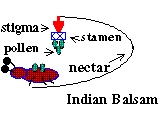
The Indian Balsam plant is an example of the incredible relationship between the pollinator and the plant. An insect enters the balsam to get a drink of nectar. It brushes pollen from stamen that is attached to the bottom of the stigma. The insect that carries away the final load of pollen also carries the stamen away and exposes the stigma, which is then ready to be pollinated by the next visitor. The Dutchman's pipe lures gnats into its large cavernous curving structure with a scent similar to a fungus on which they feed. Once a gnat enters one end of the curved structure, it mistakes the dead-end bottom for the exit because of its brightness. If the unwary gnat is carrying a supply of pollen, the fertilization of the Dutchman's pipe also triggers a mechanism that lowers its vase-like curve, opens it to the light and allows an easy exit for the gnat.
The gentian plant of South Africa can only be pollinated by a Carpenter Bee which has a particular resonance it uses to vibrate the pollen from the flower it visits. Bees that do not match this resonance cannot pollinate the flower. One would think with the vibration of the pollen, it would be scattered everywhere and self-pollination would be a problem. Not so. The stigma is not receptive until all the pollen is gone. 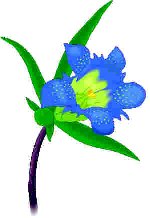 In Conclusion In Conclusion
Any study of life yields evidence of the Creator's handiwork. Botany is a feast in this regard. Any parent or teacher who gives time to its study will enrich the lives of the children within their sphere of influence. Charlotte Mason said it best: "Any woman who is likely to spend an hour or two in the society of children, should make herself mistress of this sort of information; the children will adore her for knowing what they want to know, and who knows but she may give its bent for life to some young mind destined to do great things for the world."
|
See more at - The Case for Creationism here
Other Great Links at Bible Probe
|
Figure the Odds Read: Muhammad, Terrorist or Prophet? Real
Miracles and Angel Visits The Exodus Happened
|
 Pollen
differs from plant to plant. Its macroscopic millions are carried by
wind, insects, birds, and other animals. Evolutionists claim that
fossilized remains of pollen prove it has remained much the same for
120 million years. In other words, pollen is never used as evidence
that long periods of time produce evolutionary changes. When
confronted with evolution's violation of the true scientific method
that demands observation or repeatability, evolutionists are quick
to raise the banner of endless eons of time. But when evolutionists
dig a moat of the endless ages between logic and the theory it
threatens, remember that pollen has endured unchanged throughout the
ages of this imaginary history.
Pollen
differs from plant to plant. Its macroscopic millions are carried by
wind, insects, birds, and other animals. Evolutionists claim that
fossilized remains of pollen prove it has remained much the same for
120 million years. In other words, pollen is never used as evidence
that long periods of time produce evolutionary changes. When
confronted with evolution's violation of the true scientific method
that demands observation or repeatability, evolutionists are quick
to raise the banner of endless eons of time. But when evolutionists
dig a moat of the endless ages between logic and the theory it
threatens, remember that pollen has endured unchanged throughout the
ages of this imaginary history.
 Sunflower
pollen looks like a spiked ball, while the pollen of the black
salsify looks somewhat like a diving bell with pentagon shaped
windows. (The roots of some salsify plants are edible.) Dandelion
pollen looks more like a knight's weapon than the casing of DNA that
grows a child's plaything in a spring meadow. Pollen is so
distinctive, it has been used to confirm a murderer was at the scene
of a crime; the irrefutable evidence led to his confession.
Sunflower
pollen looks like a spiked ball, while the pollen of the black
salsify looks somewhat like a diving bell with pentagon shaped
windows. (The roots of some salsify plants are edible.) Dandelion
pollen looks more like a knight's weapon than the casing of DNA that
grows a child's plaything in a spring meadow. Pollen is so
distinctive, it has been used to confirm a murderer was at the scene
of a crime; the irrefutable evidence led to his confession.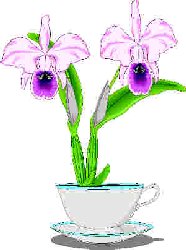 In the orchid, the
stamen is fused with the style and stigma. The pollinium is a
structure of the orchid that combines the anther and the filament
into one. The orchid is designed so that one of its petals is a
"landing platform." The insect pollinator is compelled to
land in a particular spot and and the trip to the nectar
orchestrates his pick up of the pollinium. The pollinium accompanies
the insect traveler on its next visit to a neighboring orchid where,
of course, the strategic location of the landing platform will cause
the pollen-laden pollinium to brush the surface of the stigma. If
the pollinium of the second orchid has not yet been pulled away by
an insect, the stigma is not yet exposed, so pollination will not
take place.
In the orchid, the
stamen is fused with the style and stigma. The pollinium is a
structure of the orchid that combines the anther and the filament
into one. The orchid is designed so that one of its petals is a
"landing platform." The insect pollinator is compelled to
land in a particular spot and and the trip to the nectar
orchestrates his pick up of the pollinium. The pollinium accompanies
the insect traveler on its next visit to a neighboring orchid where,
of course, the strategic location of the landing platform will cause
the pollen-laden pollinium to brush the surface of the stigma. If
the pollinium of the second orchid has not yet been pulled away by
an insect, the stigma is not yet exposed, so pollination will not
take place.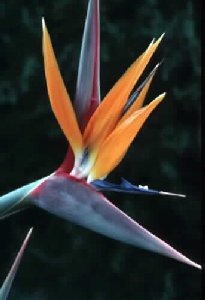 The color of a flower can give clues to what carrier is involved in
the pollination of its plant. Most plants with flowers in the red
spectrum are bird pollinated. Insects, who far outnumber birds as
pollinators, are more attracted to the blue spectrum. A bee's eyes
are sensitive to the ultraviolet spectrum. In fact, the yellow of a
marsh marigold is seen as a beautiful iridescent color known as
"bee purple."
The color of a flower can give clues to what carrier is involved in
the pollination of its plant. Most plants with flowers in the red
spectrum are bird pollinated. Insects, who far outnumber birds as
pollinators, are more attracted to the blue spectrum. A bee's eyes
are sensitive to the ultraviolet spectrum. In fact, the yellow of a
marsh marigold is seen as a beautiful iridescent color known as
"bee purple."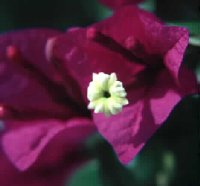 The
structure of many flowers is exactly suited to the insect that
pollinates them. The butterfly is equipped with a long roll-up
tongue that is especially suited to the thin throat of many flowers
(the bougainvillea, for example).
The
structure of many flowers is exactly suited to the insect that
pollinates them. The butterfly is equipped with a long roll-up
tongue that is especially suited to the thin throat of many flowers
(the bougainvillea, for example).